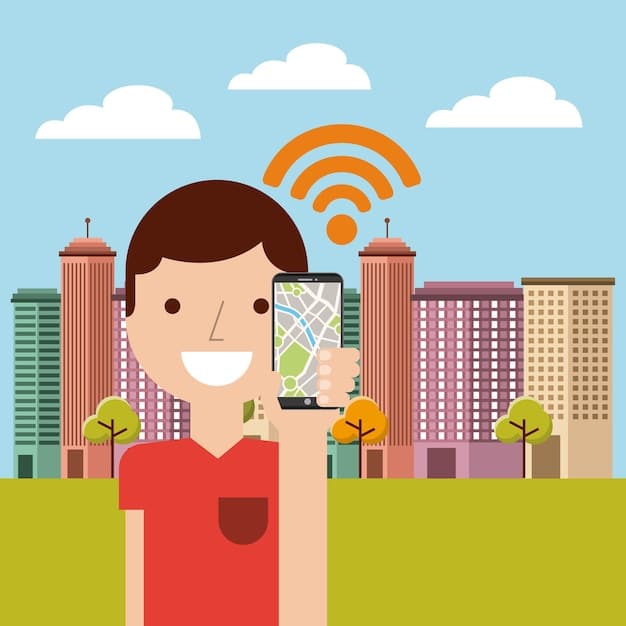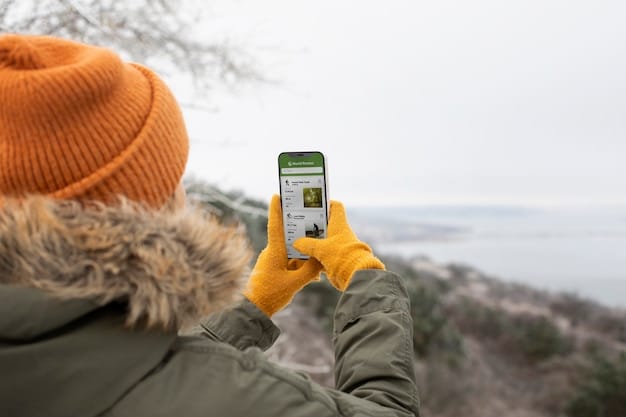Free Wi-Fi in US 2025: The Ultimate Travel Guide

The Ultimate Guide to Finding Free Wi-Fi While Traveling in the US in 2025 provides you with strategies, tools, and updated information to stay connected on the go, ensuring a seamless and cost-effective travel experience.
Staying connected while traveling in the US doesn’t have to break the bank. This The Ultimate Guide to Finding Free Wi-Fi While Traveling in the US in 2025 dives into the best tips, tricks, and resources to help you find free and reliable Wi-Fi, making your journey smoother and more enjoyable.
Understanding the Landscape of Free Wi-Fi in the US in 2025
The availability of free Wi-Fi has evolved significantly. Understanding where and how to access it is crucial for staying connected without incurring extra costs. As we move into 2025, certain trends and changes are shaping the landscape of free internet access throughout the United States.
Changes in Wi-Fi Availability
In 2025, we can expect an increased proliferation of public Wi-Fi hotspots, but distribution will vary. Urban areas will likely offer more options compared to rural regions, making it essential to plan your connectivity accordingly.
Understanding Potential Risks
While free Wi-Fi is convenient, it’s important to be aware of potential security risks. Cyber threats are constantly evolving, and public networks can be vulnerable to hacking and data breaches. Protecting your personal information requires extra vigilance.
- Use a VPN to encrypt your internet connection, especially when accessing sensitive data.
- Ensure websites you visit have HTTPS encryption to protect data transmitted between your device and the website.
- Avoid conducting financial transactions or entering personal details on unsecured Wi-Fi networks.
Stayinginformed about the landscape enables smarter and safer choices while searching for free internet access on the road.

Top Locations to Find Free Wi-Fi Hotspots
Knowing where to look can significantly simplify securing a free and reliable internet connection. These locations are good starting points when you need internet access. Let’s explore the go-to locations providing free Wi-Fi across the US.
Coffee Shops
Coffee shops like Starbucks and local cafes are known for providing free Wi-Fi to attract customers. Policies might vary, but many offer unlimited access with a purchase of a drink or snack.
Libraries
Public libraries are community hubs offering free Wi-Fi as part of their services. They are reliable and safe, making them ideal for travelers needing to catch up on work or research.
Fast Food Chains
Many fast-food restaurants like McDonald’s and Burger King offer free Wi-Fi. While speeds may vary, they can be convenient for quick access while on the go. But it’s important to note that this Wi-Fi is frequently unsecured.
Airports and Transportation Hubs
Airports, train stations, and bus terminals often provide free Wi-Fi to accommodate travelers. Look for designated hotspots or inquire at information desks for login details.
Hotels
Many hotels provide free Wi-Fi within their lobbies and common areas. Even if you’re not a guest, you might be able to access the network while spending time in these areas.
Must-Have Apps and Tools for Locating Free Wi-Fi
Several apps and digital tools exist to help travelers more effectively locate free Wi-Fi hotspots. These resources provide up-to-date information and additional features for easier connectivity. Equipping yourself with the right apps can save time and frustration.
Wi-Fi Finder Apps
Apps like Wi-Fi Finder and Netspot compile databases of free Wi-Fi hotspots. These apps often include user reviews and speed tests, helping you select the best available connection.
Map Apps with Wi-Fi Overlays
Map apps like Google Maps may include Wi-Fi hotspot overlays. These features show nearby Wi-Fi locations and can be useful for travelers exploring new areas.
VPN Apps
VPN apps like NordVPN or ExpressVPN can help secure your connections on public Wi-Fi networks. They encrypt your data and shield your online activity from potential threats.
- Download and set up these apps before you begin your travels to save time and data.
- Regularly update the apps to ensure you have the most current database of hotspots.
- Read user reviews to get insights on connection quality and reliability.
These tools assist travelers in navigating the often complex landscape of free Wi-Fi access.

Securing Your Connection on Public Wi-Fi
Using public Wi-Fi entails inherent risks. Protecting your personal information requires proactive measures when connecting to these networks. Understanding best practices and precautions is critical.
Using a Virtual Private Network (VPN)
A VPN encrypts your internet traffic, creating a secure tunnel between your device and the internet. This prevents hackers from intercepting your data on public Wi-Fi networks.
Enabling Two-Factor Authentication (2FA)
Turn on two-factor authentication for your important accounts. 2FA adds an extra layer of security, requiring a second verification method (like a code sent to your phone) in addition to your password.
Avoiding Sensitive Transactions
Refrain from conducting financial transactions or entering sensitive data on public Wi-Fi. These activities are best performed on secure, private networks.
Keeping Software Updated
Ensure your device’s operating system and apps are updated. Updates often include security patches that protect against the latest threats.
- Always verify the network name before connecting to ensure it’s legitimate.
- Disable automatic Wi-Fi connection to prevent your device from automatically joining unsecured networks.
- Regularly clear your browser’s cache and cookies to remove stored data that could be vulnerable.
These precautions provide an added shield against cyber threats.
Leveraging Wi-Fi Calling and Messaging Apps
Staying in touch without incurring extra charges is possible with Wi-Fi calling and messaging apps. These tools allow you to communicate as long as you have access to a stable Wi-Fi connection. There are good options to keep in touch and save on call and text costs.
Wi-Fi Calling
Many smartphones offer built-in Wi-Fi calling features. When enabled, your phone uses Wi-Fi to make and receive calls, bypassing traditional cellular networks.
Messaging Apps
Apps like WhatsApp, Facebook Messenger, and Telegram allow you to send messages, make voice calls, and video chat over Wi-Fi. These are popular options for staying connected internationally.
Email for Communication
Email is an effective method for non-urgent communication. Services like Gmail and Outlook provide reliable platforms for sending and receiving messages over Wi-Fi.
Wi-Fi calling and messaging apps are valuable tools if you wish to stay connected without relying on cellular service.
Future Trends in Free Wi-Fi Availability
Looking ahead, several trends are expected to shape the availability and accessibility of free Wi-Fi in the US. Staying abreast of these developments will help you better navigate the connectivity landscape. Keep an eye on how the evolving technology and infrastructures could reshape getting online freely while traveling.
5G and Wi-Fi 6 Integration
The integration of 5G technology with Wi-Fi 6 is expected to enhance the speed and reliability of public Wi-Fi networks. This will lead to a more seamless online experience for travelers.
Expansion of Municipal Wi-Fi Networks
Many cities are investing in municipal Wi-Fi networks to provide free internet access to residents and visitors. These initiatives can significantly increase the availability of free Wi-Fi in urban areas.
Private Sector Investments
Private companies, including retailers and hospitality providers, are expanding their free Wi-Fi offerings to attract and retain customers. This trend is expected to continue growing.
- Explore new smart city initiatives that may offer enhanced free Wi-Fi opportunities.
- Monitor advancements in wireless technology for improved connection speeds.
- Stay informed about regulatory changes and policies affecting public Wi-Fi access.
Preparing for future advancements ensures more efficient connectivity during your travels.
| Key Point | Brief Description |
|---|---|
| 📍 Hotspot Locations | Coffee shops, libraries, and transportation hubs often provide free Wi-Fi. |
| 🛡️ Security Measures | Use a VPN and enable two-factor authentication for safer browsing. |
| 📱 Wi-Fi Apps | Wi-Fi finder apps help you locate and evaluate available networks. |
| 📞 Wi-Fi Calling | Use Wi-Fi calling and messaging apps to save on costs. |
Frequently Asked Questions
▼
Free Wi-Fi can be risky due to potential security vulnerabilities. It’s crucial to use a VPN to encrypt your data and protect against cyber threats. Always be cautious when accessing sensitive information.
▼
Reliable free Wi-Fi can often be found at coffee shops, libraries, and major transportation hubs like airports and train stations. These locations tend to offer more stable and secure connections.
▼
Essential apps include Wi-Fi Finder, which locates available hotspots, and VPN apps like NordVPN or ExpressVPN, which secure your connection. Google Maps also displays Wi-Fi locations.
▼
To secure your connection, use a VPN to encrypt your data, enable two-factor authentication on your accounts, and avoid performing sensitive transactions on public Wi-Fi networks. Keep your software updated.
▼
Future trends include the integration of 5G and Wi-Fi 6, expansion of municipal networks, and private sector investments in free Wi-Fi offerings, promising faster and more ubiquitous access.
Conclusion
Staying connected needn’t be a costly affair when traveling in the US in 2025. By leveraging available resources, understanding potential risks, and adopting smart habits, you can enjoy seamless online access without breaking the bank. With the tips outlined in The Ultimate Guide to Finding Free Wi-Fi While Traveling in the US in 2025, you’re well-equipped to navigate the landscape of free internet access, ensuring a connected and cost-effective adventure.





